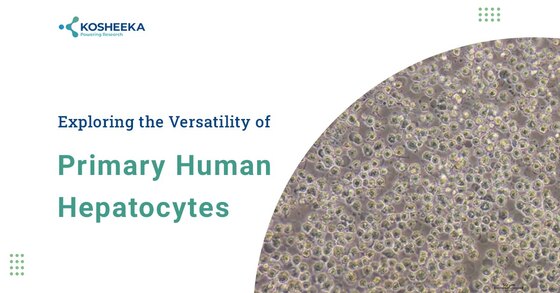Summary: Primary human hepatocytes are cells that are derived from the liver, which is an organ in the human body that performs a number of critical functions. These cells are commonly used in research and medical applications to study liver biology, drug metabolism, and disease mechanisms.
The liver is an important organ that performs many important functions in the body, including the production of bile, which helps with the digestion of fat, the production of glucose, which provides the body with energy, and the detoxification of harmful chemicals, drugs and other substances. The liver also stores vitamins and minerals and produces important proteins, including clotting factors and enzymes.
Primary human hepatocytes are cells that are obtained from the liver tissue of humans and are then used to establish cell cultures. These cells are able to maintain many of the functions of liver cells, including the ability to produce bile, detoxify drugs, and produce glucose. This makes them useful for studying the biology of the liver and for evaluating the safety and efficacy of drugs.
Hepatocytes have many advantages over other cell types. For example, they are able to perform many of the functions of liver cells, making them useful for studying liver biology and disease mechanisms. They also respond to drugs in a manner similar to human liver cells, which is important for evaluating drug safety and efficacy. Additionally, they can be used to study the effects of toxicants and other harmful substances on the liver.
Hepatocytes in Drug Metabolism
One of the key functions of primary human hepatocytes is to study the metabolism of drugs. Drugs are often metabolized by the liver, and the metabolic pathways involved can play a critical role in determining the safety and efficacy of a drug. By using primary human hepatocytes, researchers can study the metabolic pathways involved in drug metabolism and evaluate the potential for side effects and drug interactions.
Another important role for primary human hepatocytes in drug development is to evaluate the toxicity of new compounds. The liver is a primary target for the toxicity of many drugs and chemicals, and primary human hepatocytes can be used to study the effects of these substances on liver function. This information can be used to determine the safety of new drugs, as well as to develop strategies for minimizing the risk of toxicity.
Primary human hepatocytes are also useful for studying liver disease and the effects of liver disease on drug metabolism. Diseases such as cirrhosis and hepatitis can alter the metabolism of drugs, and primary human hepatocytes can be used to study these changes and develop strategies for optimizing drug therapy in patients with liver disease.
ADME Studies
Primary human hepatocytes play a significant role in the evaluation of the pharmacokinetics, or ADME (Absorption, Distribution, Metabolism, Excretion), of new drugs. ADME refers to the processes by which drugs are absorbed into the body, distributed to their target tissues, metabolized, and then excreted. Understanding these processes is critical for determining the safety and efficacy of new drugs.
These cells can also be used to evaluate the toxicity of new compounds. As the liver is a primary target for the toxicity of many drugs and chemicals, primary human hepatocytes can be used to study the effects of these substances on liver function. This information can be used to determine the safety of new drugs, as well as to develop strategies for minimizing the risk of toxicity.
Study of Liver Functions
Primary human hepatocytes provide a way to study the basic biology of liver cells, including the production of bile, glucose, and important proteins, as well as the detoxification of harmful chemicals and drugs. This information can be used to better understand the mechanisms of liver function and disease.
It can be used to study the complex signalling pathways that occur in liver cells and regulate liver function. This information can be used to better understand the mechanisms of liver disease and develop new strategies for treating liver disease.
The Study of Liver Signalling
The study of liver cell signalling is an important area of research that aims to understand the complex signalling pathways that occur in liver cells and regulate liver function. Primary human hepatocytes play a critical role in this area of research due to their ability to perform many of the functions of liver cells in a laboratory setting.
Primary human hepatocytes can be used to study a wide range of signalling pathways that occur in liver cells, including those involved in regulating cell growth and division, bile production, glucose metabolism, and drug metabolism. By using primary human hepatocytes, researchers can evaluate the effects of different signalling pathways on liver cell function, and identify the pathways that are most important for maintaining liver health.
The study of liver cell signalling is critical for advancing our understanding of liver biology and disease, and for developing new strategies for treating liver disease. For example, by identifying signalling pathways that are disrupted in liver diseases such as cirrhosis and hepatitis, researchers can develop new drugs to target these pathways and improve the health of patients with liver disease.
Conclusion
In conclusion, primary human hepatocytes play a critical role in the development of new drugs. By providing a way to study drug metabolism, toxicity, and the effects of liver disease, they help researchers and pharmaceutical companies make informed decisions about the safety and efficacy of new drugs. Their use in drug development is essential for improving the health and well-being of patients.
The study of liver cell signalling using primary human hepatocytes is an important area of research that holds great promise for improving our understanding of liver biology and disease, as well as for developing new strategies for treating liver disease. These studies will help to advance our understanding of the liver function and improve the health and well-being of patients.


